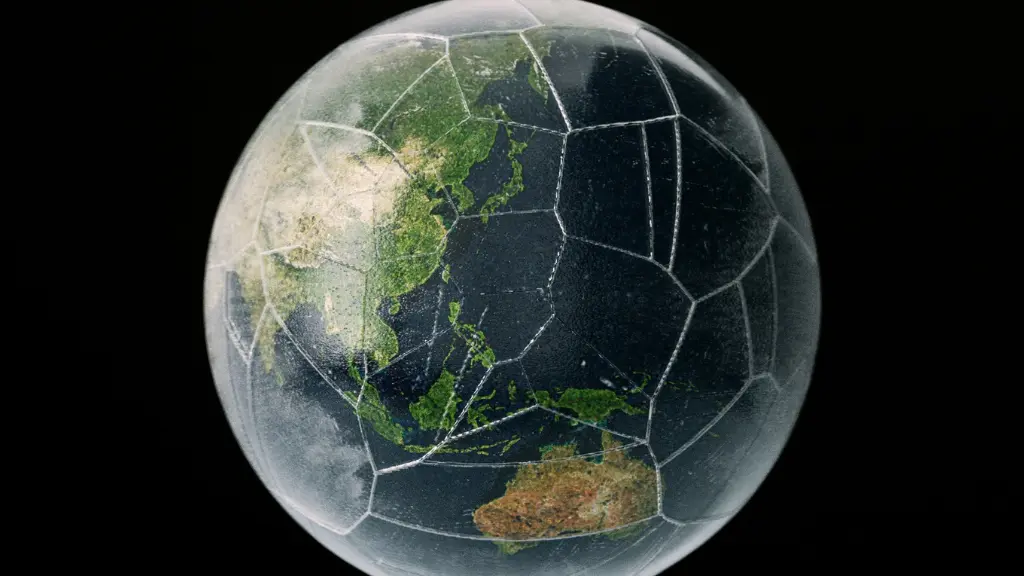

The Earth’s core is a fascinating and mysterious part of our planet. As the very center of the earth core, it plays a crucial role in the planet’s overall structure and behavior. The core is made up of two distinct parts: the inner core and the outer core.
The inner core is a solid sphere composed of iron and nickel, with a diameter of approximately 1,200 kilometers. It is surrounded by the outer core, which is a layer of molten metal that is about 2,300 kilometers thick. Together, these two layers make up about 15% of the Earth’s total volume. The core is also incredibly hot, with temperatures reaching up to 6,000 degrees Celsius at the center.
Scientists have been studying the Earth’s core for decades, but there is still much that remains unknown. However, recent advances in technology have allowed researchers to gain a better understanding of this mysterious region. In this article, I will explore the Earth’s core in more detail, including its composition, behavior, and the role it plays in shaping our planet.

The Earth’s core is the central part of our planet, located beneath the mantle and crust. It is divided into two layers: the solid inner core and the liquid outer core. The composition of the Earth’s core is a subject of great interest to scientists, as it helps us understand the formation and evolution of our planet.
The chemical composition of the Earth’s core is believed to be primarily iron (Fe) and nickel (Ni). These elements make up more than 80% of the core’s mass, with smaller amounts of other elements such as sulfur (S), oxygen (O), and silicon (Si). The exact composition of the core is difficult to determine, as it is impossible to directly observe it. However, scientists have been able to make inferences about the core’s composition based on seismic data and experiments.
The solid inner core of the Earth is believed to be composed mostly of iron, with smaller amounts of nickel and other elements. It is estimated to have a radius of approximately 1,220 kilometers and a temperature of around 5,000 degrees Celsius. Despite its high temperature, the inner core remains solid due to the immense pressure it is under.
The liquid outer core of the earth core is also primarily composed of iron and nickel, but it also contains lighter elements such as sulfur and oxygen. It is estimated to have a thickness of approximately 2,300 kilometers and a temperature of around 4,000 degrees Celsius. The Earth’s magnetic field, which shields us from dangerous solar radiation, is generated by the outer core.
In conclusion, the composition of the earth core is primarily made up of iron and nickel, with smaller amounts of other elements. The solid inner core and liquid outer core play important roles in the Earth’s geology and earth magnetic core field. Further research is needed to fully understand the composition and behavior of the Earth’s core.

As a geophysicist, I have always been fascinated by the dynamics of the earth core. The core is a complex system that consists of two distinct layers, the inner core, and the outer core. In this section, I will explore the movements and heat transfer within the core.
The Earth’s core is constantly in motion. The core earth magnetic field, which shields us from dangerous solar radiation, is generated by the outer core. The movement of the outer core is driven by the heat generated from the inner core and the cooling of the outer core at the top. This movement is known as convection.
The rotation of the Earth also plays a key role in the core’s movement. The Coriolis effect causes the convection currents to rotate in a clockwise direction in the Northern Hemisphere and counterclockwise in the Southern Hemisphere. This rotation creates a dynamo effect, which generates the Earth’s magnetic field.
The inner core, on the other hand, rotates independently of the outer core. The rotation of the inner core is slightly faster than the rotation of the Earth’s surface, completing a full rotation every 24 hours. This rotation generates a small amount of energy, which is believed to be responsible for maintaining the core’s magnetic field.
The core earth science is extremely hot, with temperatures rising to as high as 6,000 degrees Celsius. The heat is generated from the decay of radioactive isotopes and residual heat from the Earth’s formation. The heat is then transferred from the inner core to the outer core through conduction.
The cooling of the outer core at the top creates a temperature gradient, which drives the convection currents. As the hot material rises, it cools and sinks back down, creating a continuous cycle of heat transfer.
In conclusion, the dynamics of the Earth’s core are a complex system of movements and heat transfer. The core’s movements are driven by convection and the rotation of the Earth, while the heat is generated from the decay of radioactive isotopes and residual heat from the Earth’s formation. Understanding the dynamics of the core is crucial in understanding the Earth’s magnetic field and the processes that shape our planet.

As an Earth scientist, I find the study of the Earth’s magnetic field to be fascinating. The magnetic field is an important aspect of our planet and plays a crucial role in our daily lives. In this section, I will discuss the role of the Earth’s core in generating and maintaining the magnetic field.
The Earth’s magnetic field arises from the movement of molten iron within the outer core. The outer core is a layer of liquid iron that surrounds the solid inner core. The motion of the molten iron generates electrical currents, which in turn produce the magnetic field.
The magnetic field is not static, but rather it is constantly changing. The magnetic poles can move and even reverse polarity over time. These changes are due to the complex dynamics of the Earth’s core and its interactions with the mantle and crust.
Geomagnetic reversals are the most dramatic changes in the Earth’s magnetic field. During a reversal, the magnetic field weakens and the magnetic poles switch places. The last reversal occurred about 780,000 years ago, and scientists are still trying to understand the mechanisms that cause these reversals.
One theory is that the reversals are caused by changes in the flow of molten iron in the outer core. As the flow changes, the magnetic field weakens and eventually reverses. Another theory is that the reversals are caused by the interactions between the core and the mantle.
In conclusion, the earth core magnetic field is a complex and dynamic system that is generated and maintained by the motion of molten iron in the outer core. The magnetic field plays a crucial role in our daily lives, from guiding compasses to protecting us from harmful solar radiation. Understanding the role of the core in Earth’s magnetism is an important area of study for Earth scientists.

As an Earth scientist, I find the study of the earth core to be fascinating. The Earth’s core is the innermost part of our planet, consisting of a solid inner core and a liquid outer core. The core makes up about 15% of the Earth’s volume and 32% of its mass. Despite its importance, studying the Earth’s core is a challenging task due to its inaccessibility.
One of the primary methods used to study the earth core is seismic wave analysis. Seismic waves are waves of energy that travel through the Earth’s interior, and they can provide valuable information about the properties of the Earth’s core. By analyzing the travel times and amplitudes of seismic waves, scientists can infer the density, temperature, and composition of the Earth’s core.
Another method used to study the earth core is computational simulation. This involves using computer models to simulate the behavior of the Earth’s core under different conditions. By varying parameters such as temperature, pressure, and composition, scientists can gain insights into the dynamics of the Earth’s core and how it influences the Earth’s magnetic field.
In conclusion, studying the earth core is a complex and challenging task that requires the use of multiple methods and techniques. Through seismic wave analysis and computational simulation, scientists are gaining a better understanding of the Earth’s core and its role in shaping the planet we live on.

As someone who has studied the earth core, I can confidently say that the core is one of the most fascinating and important parts of our planet. It is located at the very center of the Earth and is made up of two core in earth layers: the inner core and the outer core.
The boundary between the earth core and the mantle is known as the core-mantle boundary. It is located approximately 2,900 kilometers below the Earth’s surface. The boundary is marked by a sharp increase in density and a change in the behavior of seismic waves that pass through it.
The core-mantle boundary is a very important area of study for geologists and seismologists. It is believed that the boundary plays a crucial role in the movement of tectonic plates and the formation of volcanic activity. The boundary is also thought to be responsible for generating the Earth’s magnetic field.
The interactions between the core and the crust are also very important. The earth core heat drives the movement of tectonic plates, which in turn shapes the Earth’s surface. The core also plays a role in the formation of mountains, as the movement of tectonic plates can cause the crust to buckle and fold.
In addition, the earth core magnetic field is responsible for protecting the Earth from the harmful effects of solar wind and cosmic radiation. Without this magnetic field, life on Earth would be much more difficult, if not impossible.
Overall, the earth core is a crucial part of the Earth’s interior. Its interactions with the mantle and crust are responsible for many of the geological processes that shape our planet. Through continued study and research, we can gain a better understanding of the core and its role in our planet’s history and future.

As someone who has studied the core of planet earth core, I can confidently say that it has a significant influence on surface phenomena. In this section, I will discuss two major ways in which the core affects the Earth’s surface: volcanic activity and tectonic movements.
The earth core plays a crucial role in the generation of volcanic activity. Magma, which is molten rock that is found beneath the Earth’s surface, is created by the melting of rocks in the mantle and crust. This melting is caused by the high temperatures and pressures that exist deep within the Earth, which are ultimately generated by the heat that is released by the core.
The earth core also influences the composition of magma. The core is primarily made up of iron and nickel, and these elements are thought to be the source of the iron and nickel that is found in magma. Additionally, the core’s magnetic field can affect the movement of magma, which in turn can affect the location and intensity of volcanic eruptions.
The earth core also plays a significant role in tectonic movements, which are the movements of the Earth’s crustal plates. The core’s heat is thought to be the primary driver of these movements, as it causes convection currents in the mantle. These currents, in turn, drive the movement of the crustal plates.
The earth core also affects the composition and strength of the crustal plates. The heat generated by the core causes the rocks in the mantle and crust to be more ductile, which means that they are more easily deformed. This can lead to the formation of faults and fractures in the crustal plates, which can ultimately lead to earthquakes.
In conclusion, the core of earth core has a significant influence on surface phenomena, particularly volcanic activity and tectonic movements. Understanding the role of the core in these processes is crucial for predicting and mitigating the effects of natural disasters such as volcanic eruptions and earthquakes.

As a geologist, I find the earth core to be a fascinating subject. It not only affects the planet’s magnetic field but also has an impact on the oceans. In this section, I will discuss the relationship between the Earth’s core and the oceans.
The earth core generates heat, which is transferred to the surface through convection. This heat drives the thermohaline circulation, which is responsible for the movement of water in the oceans. The thermohaline circulation is driven by differences in temperature and salinity, which create density gradients in the ocean.
The warm water from the equator flows towards the poles, where it cools and sinks to the bottom of the ocean. This cold water then flows back towards the equator, completing the circulation. This process plays a crucial role in regulating the earth core climate by distributing heat around the planet.
The Earth’s core also has an impact on sea level changes. The gravitational pull of the Moon and the Sun causes tides, which can be affected by changes in the Earth’s magnetic field. The magnetic field is generated by the motion of molten iron in the earth core, which can be influenced by external factors such as solar storms.
Changes in sea level can also be caused by the melting of glaciers and ice caps, which is influenced by the Earth’s core. The melting of ice can cause changes in the distribution of mass on the earth core surface, which can affect the planet’s rotation and gravitational field.
In conclusion, the earth core plays a significant role in the functioning of the oceans. The thermohaline circulation and sea level changes are just two examples of the complex relationship between the Earth’s core and the oceans. As a geologist, I find this relationship to be a fascinating subject for further study.

As a researcher in Earth core science, I am excited about the future possibilities for exploration and discovery. There is still so much we do not know about the inner workings of our planet, and I believe that continued research and exploration will lead to new insights and a deeper understanding of Earth’s core.
One area of particular interest is the study of seismic waves. By analyzing the way that seismic waves travel through the earth core, we can gain valuable information about the composition and structure of the core. Ongoing research in this area could lead to new discoveries about the properties of the core and the processes that take place within it.
Another promising avenue for future research is the use of computer modeling and simulation. By creating detailed models of the earth core, we can simulate the behavior of different materials and test various hypotheses about core processes. This approach has already yielded some exciting results, and I believe that continued investment in this area will lead to even more breakthroughs.
In addition, I believe that there is still much to be learned from direct exploration of the earth core. While this is a daunting task, new technologies and techniques are emerging that could make it possible. For example, the development of advanced drilling techniques and materials could allow us to penetrate deeper into the Earth’s crust and reach the core. Similarly, advances in robotics and remote sensing could enable us to explore the core without physically entering it.

Overall, I am optimistic about the future of Earth core science and the potential for new discoveries and insights. By continuing to invest in research and exploration, we can deepen our understanding of our planet and the forces that shape it. See more articles like this by clicking here: Cole Parmer Antylia: A Detailed Review.